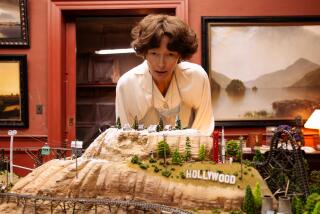A band’s slow, edgy breakup
- Share via
AFTER more than a decade as college radio faves and critical darlings without crossing over to more mainstream success, the indie-rock band Luna decided to call it quits in 2004. The quartet’s bittersweet farewell tour is the subject of the introspective documentary “Tell Me Do You Miss Me,” directed by Matthew Buzzell.
Mixing concert performances with tour footage from Japan, Spain and across the U.S., Buzzell captures the road-weary foursome as it bids goodbye to its ardent fans. Playing before crowds of 500 to 1,000, Luna delivers a melancholy sound that is a pitch-perfect backdrop to the story of a group of thirty- and fortysomethings reaching a crossroads.
Luna evolved from demos made by singer-songwriter Dean Wareham, formerly of the Boston group Galaxie 500, in 1991. Wareham recorded with different musicians before the band’s first touring lineup, which included guitarist Sean Eden, coalesced in 1992. Lee Walls succeeded Stanley Demeski as the drummer in 1997 and multi-instrumentalist and vocalist Britta Phillips came aboard in 1999, replacing Justin Harwood on bass and keyboards.
If the band’s songs, as well as a plaintive cover of “Everybody’s Talkin’,” resonate like a soundtrack for a divorce, then it may not be a coincidence that Wareham and Phillips (a couple themselves) went on to score Noah Baumbach’s tragicomic chronicle of a marriage’s dissolution, “The Squid and the Whale.”
The unknown path that lay ahead looms throughout “Tell Me Do You Miss Me,” though a lot of time is devoted to reminiscing about previous tours. Petty squabbles over what happened when give the journey the feel of a slow, edgy breakup between lovers who have grown tiresome to one another. Wareham and Eden’s interactions, especially, provide insight into the rigors of surviving as musicians at a level that doesn’t include sports arenas and limousines. This is rock stardom on a shoestring, where T-shirt sales determine whether a tour makes any money.
An L.A. story
Rising nearly 100 feet above South Los Angeles from its perch on 107th Street, the Watts Towers stand as an often overlooked symbol of the city. Completed in 1954 by an Italian immigrant named Sam Rodia, who worked on the project for 30 years, the towers have withstood earthquakes, riots and the threat of demolition. Filmmakers Edward Landler and Brad Byler (a maternal great-nephew of Rodia) pay worthy tribute to Rodia and his structure with the expansive documentary “I Build the Tower.”
Consisting of 17 interlocking structures, the towers are dominated by three spires, made conspicuous by the lattice-like superstructure that covers them. Decorated with pottery shards and colorful pieces of broken glass, and made using simple hand tools, they stand in stark contrast to the modern, automated world Rodia detested. When asked by a reporter about his impulse to create the towers, the artisan responded, “Why I built it, I can’t tell-a you. Why a man makes the pants? Why a man makes the shoes?”
The film itself took more than 20 years to make, meticulously detailing Rodia’s sometimes tumultuous life and the fate of his most famous creation. He left Watts shortly after finishing the towers, spending his remaining years in Northern California, and died at age 90 in 1965 -- weeks before the riots that would approach but not harm his artwork. Vintage audio recordings bring the enigmatic sculptor to life as he rages against capitalism and industrialization.
Landler and Byler celebrate the towers as an artistic achievement and the fruit of one man’s obsession while attempting to place them in a cultural context. An interview with inventor and theorist Buckminster Fuller in 1983 (the year he died) intricately analyzes the surprisingly sophisticated techniques Rodia employed despite his rudimentary tools and materials.
Southern California social critic Mike Davis champions the towers as an icon that “ordinary people have embraced as the city’s most profound, most poignant symbol.” Astutely blending interviews with archival footage, the filmmakers also stunningly capture the beauty of the towers as the spires pierce the azure sky, reaching far beyond Rodia’s aspirations.
Eclectic black films
The Hollywood Black Film Festival continues through Sunday with a full slate of features, documentaries, shorts and discussions. Two of the shorts programs represent the eclectic nature of the offerings.
“Renaissance Men in Film” is highlighted by writer-director Eric Haywood’s sleekly engaging drama, “Intersection.” Terrell Tilford and Taji Coleman star as an ambitious couple who are so perfect for each other that even their indiscretions have a certain synchronicity.
The short films that make up “Sex After Dark ... For Adults Only” belie that flippant title to address some serious subjects. “On the Low,” written and directed by Luther M. Mace, describes the conflicted relationship of two male high school students pursuing forbidden love in a testosterone-fueled environment. In the psychosexual drama “Trespass,” Brickland (J. David Shanks) confronts his adopted brother Donnie (Nelsam Nerie Ellis) about the events that led Donnie to be incarcerated in a mental institution.
*
Screenings
Music Documentary
* “Tell Me Do You Miss Me”: 7 and 9:30 p.m. Friday and Saturday
Where: Spielberg Theatre at the Egyptian, 6712 Hollywood Blvd., Hollywood
Info: (323) 466-FILM, www.egyptiantheatre.com
Alternative Screen
* “I Build the Tower”: 7:30 tonight
Where: Lloyd E. Rigler Theatre at the Egyptian, 6712 Hollywood Blvd., Hollywood
Info: (323) 466-FILM, www.egyptiantheatre.com
Hollywood Black Film Festival
* “Renaissance Men in Film -- Shorts Program”: 6 tonight
* “Sex After Dark ... For Adults Only -- Shorts Program No. 4”: 9 tonight
Where: Fine Arts Theatre, 8556 Wilshire Blvd., Beverly Hills
Info: www.hbff.org
More to Read
The biggest entertainment stories
Get our big stories about Hollywood, film, television, music, arts, culture and more right in your inbox as soon as they publish.
You may occasionally receive promotional content from the Los Angeles Times.











